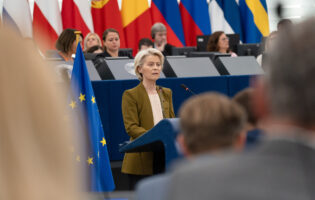
Miroslav Vajdic via flickr
Race to the East? China Revives the 17+1 Summit

Yixiang Xu
China Fellow; Program Officer, Geoeconomics
Yixiang Xu is the China Fellow and Program Officer, Geoeconomics at AGI, leading the Institute’s work on U.S. and German relations with China. He has written extensively on Sino-EU and Sino-German relations, transatlantic cooperation on China policy, Sino-U.S. great power competition, China's Belt-and-Road Initiative and its implications for Germany and the U.S., Chinese engagement in Central and Eastern Europe, foreign investment screening, EU and U.S. strategies for global infrastructure investment, 5G supply chain and infrastructure security, and the future of Artificial Intelligence. His written contributions have been published by institutes including The Chinese Academy of Social Sciences, The United States Institute of Peace, and The Asia Society's Center for U.S.-China Relations. He has spoken on China's role in transatlantic relations at various seminars and international conferences in China, Germany, and the U.S.
Mr. Xu received his MA in International Political Economy from The Josef Korbel School of International Studies at The University of Denver and his BA in Linguistics and Classics from The University of Pittsburgh. He is an alumnus of the Bucerius Summer School on Global Governance, the Global Bridges European-American Young Leaders Conference, and the Brussels Forum's Young Professionals Summit. Mr. Xu also studied in China, Germany, Israel, Italy, and the UK and speaks Mandarin Chinese, German, and Russian.
__
Last month, Beijing suddenly announced a plan to host a digital 17+1 one summit in February, bringing its relationship with Central and Eastern European countries (CEEC or CEE) back into public view. The initiative was already losing its luster after eight annual summits. Then, in early 2020, the Covid-19 pandemic put an abrupt stop to immediate Chinese efforts to prolong its life.
For months, the prospect of restarting the multilateral summit remained muddy. Even before the pandemic, participating members in the CEE region openly questioned its utility. CEE governments had hoped the initiative could attract more direct Chinese investment to the region. But the bulk of China’s investment went to five non-EU members in the Balkans, and the rest largely concentrated in Hungary, Poland, and the Czech Republic, leaving many CEE capitals including Warsaw and Prague thoroughly underwhelmed. As bilateral trade grew, reaching $103.45 billion according to the Chinese government, CEE countries’ trade deficit with China also balloned, while local exports to China saw only modest growth. The anticipated economic benefits of a closer relationship with China seems rather asymmetric.
China’s diplomatic performance during the pandemic further added to the chorus of critical voices in the region. After the initial dash to secure masks and other PPE through Chinese channels, many CEE countries were soon alarmed and appalled by Beijing’s pandemic-related disinformation and propaganda efforts in Europe as well as Chinese “Wolf Warrior” diplomats who publicly attack and threaten China’s critics. It’s a hard lesson that Beijing will define both the terms as well as the results of its partnerships.
With China, the EU, and the United States increasingly competing for geopolitical influence, a line to Beijing and face time with top Chinese leaders may provide additional incentives for all interested parties to up their games with CEE countries.
China may be down, but it’s certainly not out. Despite growing CEE skepticism toward China and the 17+1 initiative, no CEE member openly rejected China’s call to revive the summit. With China, the EU, and the United States increasingly competing for geopolitical influence, a line to Beijing and face time with top Chinese leaders may provide additional incentives for all interested parties to up their games with CEE countries.
The EU has repeatedly voiced concerns about Chinese activities in the CEE region. Brussels also warned that continued China-CEE exchanges could undermine a coherent EU approach to China. Sure, growing Chinese influence in the Balkans and EU members like Hungary raises serious questions regarding fiscal responsibility, environmental pollution, and even erosion of democratic governance. But if Angela Merkel could push through the EU-China Comprehensive Agreement on Investment (CAI) despite internal EU dissent, why shouldn’t Warsaw or Prague or Bucharest call up Xi Jinping to advocate their own business plans? Despite continuing EU support for CEE economic development, creative solutions, hard commitments, and equitable input into the EU’s policy decisions on China are much more effective than critical rhetoric in securing CEE solidarity.
That very sentiment has already laid ground for increased U.S. engagement in the CEE region. The Trump administration’s campaign against Chinese telecommunications company Huawei led to multiple tours of top U.S. government officials across the region. Those efforts saw most CEE members signing up for the Prague Proposals that call for scrutinization of 5G vendors and their home governments, joint declarations supporting the U.S. “Clean Network” campaign, as well as a number of CEE countries such as Poland and Romania excluding Huawei from their 5G networks. Washington also publicly supported the Three Seas Initiative (3SI) and committed up to $1 billion for its funding.
Beijing’s challenges now also include souring regional public opinion, an expanding regional network of independent China critics, and potential for growing U.S.-CEE security synergy.
As it’s increasingly clear that the Biden administration will hold a hardline toward China, with President Biden calling the relationship with Beijing “extreme competition,” some in the CEE region see an opportunity for closer U.S.-CEE partnership. They argue that CEE countries are more in tune with Washington’s national security assessment toward China than its Western European neighbors and the deepening Sino-Russian security and technology cooperation greatly alarms government officials from Tallin to Sofia. For CEE countries, it seems, the road to Washington could run through Beijing.
China, for its part, is increasingly aware that its old tactic in the region may not help it score another easy diplomatic win. Beijing’s decision to upgrade the 17+1 summit with Xi Jinping as host and its creation of a range of additional China-CEE initiatives, including agriculture expos and cloud service dialogues, are clear indications of China’s renewed focus to sway the CEE region and leverage Europe amid a prolonged global strategic competition with the United States. Aside from its still decidedly bilateral diplomatic engagement with CEE countries and an underwhelming record, Beijing’s challenges now also include souring regional public opinion, an expanding regional network of independent China critics, and potential for growing U.S.-CEE security synergy. How China defines the 17+1 agenda at the upcoming summit could provide important clues to its future fortunes in the region.







